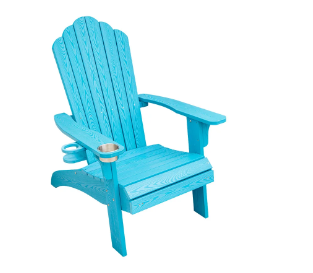Email format error
Email cannot be empty
Email already exists
6-20 characters(letters plus numbers only)
The password is inconsistent
Email format error
Email cannot be empty
Email does not exist
6-20 characters(letters plus numbers only)
The password is inconsistent


In the realm of outdoor furniture, commercial Adirondack chairs have emerged as iconic staples, resonating with businesses seeking durability, aesthetic appeal, and comfort. This article embarks on a comprehensive journey, unraveling the historical tapestry, elucidating the multifaceted benefits, scrutinizing materials, and juxtaposing these chairs with alternative outdoor seating options, thereby empowering decision-makers across diverse industries.
Origin and Genesis:
The narrative of Adirondack chairs finds its roots in the early 20th century, with Thomas Lee's ingenious design conceived amidst the serene landscapes of the Adirondack Mountains. The initial blueprint, characterized by its ergonomic contours and simplistic elegance, resonated with nature enthusiasts and leisure seekers, laying the foundation for subsequent innovations.
Milestones and Innovations:
As time unfurled, commercial Adirondack chairs transcended their rustic origins, embracing contemporary design elements and technological advancements. Architects, designers, and craftsmen converged, infusing the classic Adirondack silhouette with modern materials, innovative finishes, and ergonomic enhancements. This evolution mirrors broader societal shifts, reflecting changing consumer preferences, sustainability imperatives, and technological innovations in outdoor furniture design.
Durability and Longevity:
At the forefront of their benefits, commercial Adirondack chairs epitomize durability. Crafted meticulously from premium-grade materials such as cedar, teak, or eco-conscious composites, these chairs withstand the ravages of time, environmental extremes, and rigorous usage. For businesses, this translates into prudent investments, minimizing replacement cycles, and optimizing operational efficiencies.
Aesthetics, Branding, and Ambiance:
Beyond their functional attributes, Adirondack chairs serve as potent branding tools, infusing commercial spaces with distinctive aesthetics and ambiance. Whether adorning seaside resorts, alpine lodges, or urban rooftops, their timeless design and aesthetic versatility amplify brand narratives, evoke emotive connections, and foster memorable customer experiences.
Comfort, Ergonomics, and Wellbeing:
Prioritizing user-centric design principles, commercial Adirondack chairs prioritize comfort and ergonomics. The ergonomic contours, spacious seating profiles, and supportive backrests cater to diverse user demographics, promoting relaxation, enhancing wellbeing, and fostering convivial interactions in commercial settings, from cafes to corporate courtyards.

Materials Palette and Sustainability:
The material selection for commercial Adirondack chairs underscores sustainability, durability, and aesthetic appeal. While traditionalists favor cedar and teak for their natural beauty and longevity, contemporary iterations embrace eco-friendly composites, recycled plastics, and innovative alloys. This diversified material palette aligns with sustainability imperatives, circular economy principles, and evolving consumer expectations for eco-conscious products.
Craftsmanship, Quality Assurance, and Innovation:
Beyond materials, the craftsmanship and construction methodologies employed in crafting Adirondack chairs are paramount. Expert artisans, leveraging centuries-old techniques and state-of-the-art technologies, ensure precision, durability, and aesthetic coherence. Quality assurance protocols, rigorous testing regimes, and continuous innovation cycles further elevate the quality quotient, distinguishing commercial Adirondack chairs in competitive markets.
Economic viability and total cost of ownership:
Evaluating economic viability, commercial Adirondack chairs present a compelling value proposition. While initial acquisition costs may vary, their extended lifespan, minimal maintenance requirements, and resale value mitigate long-term expenditures, optimizing the total cost of ownership for businesses across sectors.
Durability, Maintenance, and Lifecycle Analysis:
Comparing durability and maintenance aspects, Adirondack chairs demonstrate resilience against environmental factors, rigorous usage, and wear-and-tear. This longevity, coupled with reduced maintenance intervals and associated costs, resonates with sustainability metrics, lifecycle assessments, and corporate sustainability initiatives, positioning Adirondack chairs favorably against alternative seating solutions.
Aesthetic Resonance, Design Flexibility, and User Experience:
From a design perspective, commercial Adirondack chairs offer unparalleled aesthetic resonance, design flexibility, and user-centric experiences. Their adaptability to diverse environments, seamless integration with architectural motifs, and ergonomic prowess differentiate them from conventional seating alternatives, enhancing user satisfaction, brand loyalty, and commercial viability.
In summation, commercial Adirondack chairs transcend conventional outdoor seating paradigms, embodying a rich tapestry of history, benefits, materials, and comparative advantages. By navigating their evolutionary trajectory, harnessing their multifaceted benefits, understanding materials and construction nuances, and critically comparing them with alternative options, businesses can orchestrate immersive, sustainable, and memorable customer experiences in diverse commercial landscapes.